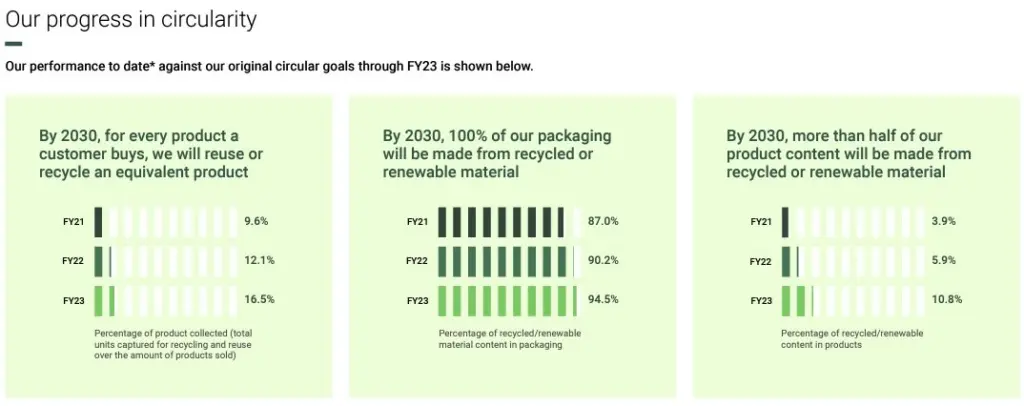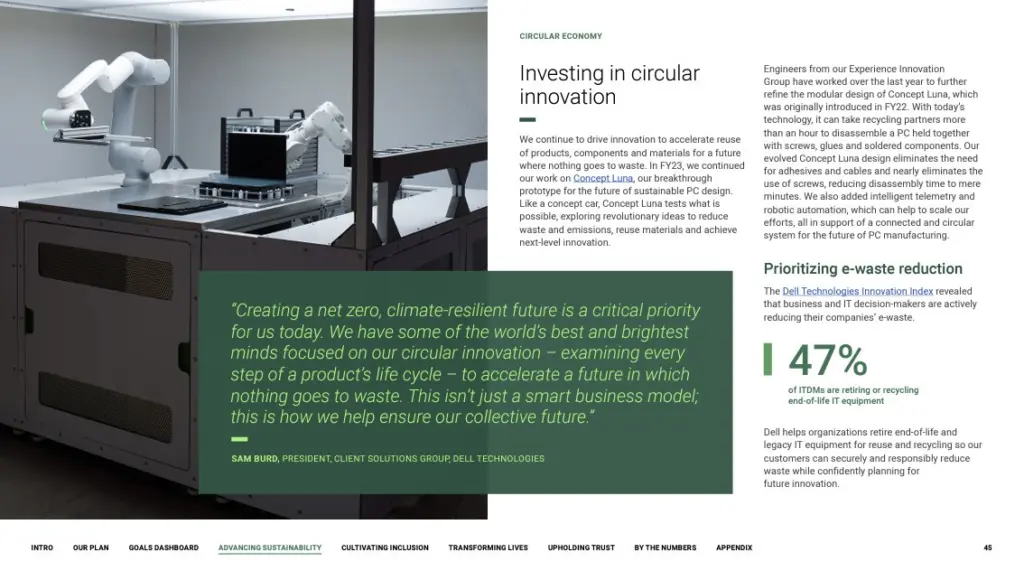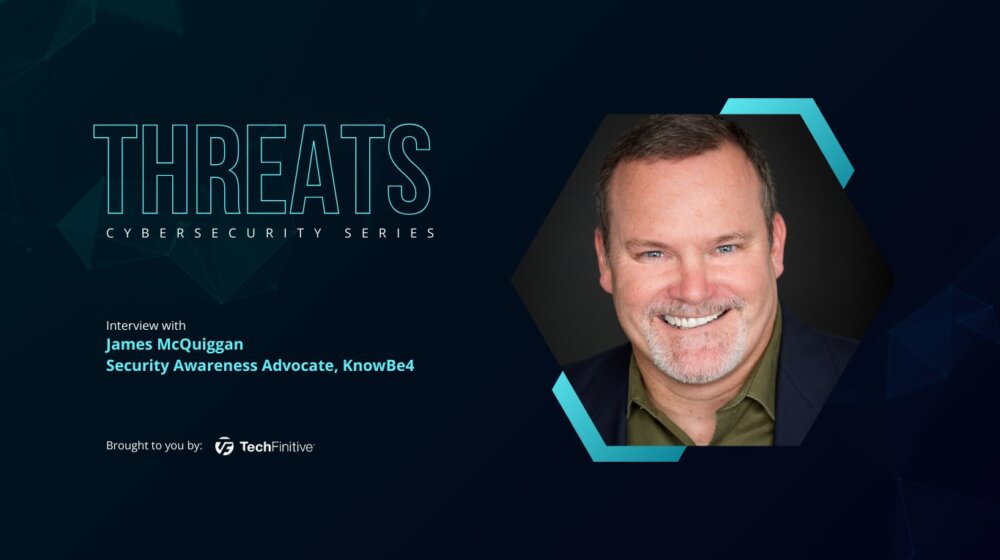
How will Dell address the emerging sustainability challenges expected in 2024?
Dell delivered a record $102.3 billion in revenue for 2023, making it one of the world’s technology superpowers. Behind its operation and products is an ambitious multi-faceted sustainability strategy to reduce greenhouse gas emissions, minimise waste and promote recycling initiatives to benefit the company and its customers.
However, as any company continues to expand, meeting environmental targets becomes increasingly complex. How will Dell address the emerging sustainability challenges expected in 2024?
Inside Dell’s 2023 ESG
Dell’s 2023 ESG report (FY23) is impressively mature and, given the size of the company, it’s no surprise that it runs to over 150 pages. Dell’s ESG governance is led by the ESG Steering Committee and executed by the ESG Interlock Team, but there is no place on the board for an ESG director. Instead, the ESG Steering Committee provides updates to the Dell executive leadership team, board of directors and ESG councils.
This year, Dell has four areas of focus: Advancing Sustainability, Cultivating Inclusion, Transforming Lives and Upholding Trust. We’re going to focus on the largest section of the report, Advancing Sustainability. This section is 45% larger than Dell’s other three combined. It has a broad scope covering climate change, circular economy, and both social and environmental responsibility.
How will Dell achieve net zero by 2050?
Dell remains committed to achieving net zero emissions by 2050 through what it calls Scopes 1–3. It can’t be understated how challenging this is for a global manufacturer, so to help the company align its emission targets, it has adopted a methodology developed by the Science Based Targets initiative (SBTi). This a partnership between CDP, the United Nations Global Compact, World Resources Institute (WRI) and the Worldwide Fund for Nature (WWF).
Dell’s work with the SBTi has set ambitious 2030 targets. For Scope 1 (direct emissions), these include:
- Focus on eliminating GHG-emitting fuels in its buildings and vehicles
- Transition to low- or no-emissions cooling systems for its buildings and equipment
For Scope 2 (indirect emissions):
- Focus on sourcing 75% of electricity from renewable sources by 2030
- Drive scope 2 emissions to nearly zero by sourcing 100% of electricity from renewable sources by 2040
By 2030, Dell plans to have reduced its operational emissions (Scopes 1 and 2) by 50%.
Reducing Scope 3 emissions presents the toughest challenge for any company as these are associated with the multitude of other companies that create its supply and value chain. By 2030, Dell hopes to reduce the emissions from purchased goods and services by 45% and the absolute emissions associated with the use of sold products by 30%.
It’s encouraging to see that Dell’s 2050 strategy has ambitious benchmark steps for 2030 and 2040. Its commitments to net zero are underlined by its allegiance with SBTi, which grades and publicises the efforts of the corporations which use the service. For more information about Dell’s work with the SBTi, take a look at its case study.
Dell also aims to learn from its Technologies Innovation Index, which is a feedback pool of over 6,600 businesses and decision-makers on how they are using technology to incorporate sustainable innovation.
What is Dell’s view of the circular economy?

Dell’s framework also relates to the circular economy. It reports that for FY23, it recovered 16.5% of products sold to its customers, representing an encouraging 4.4% improvement from FY22.
Dell’s well-established ‘Technology Rotation’ model (leasing, in old money!) undoubtedly can drive its reuse initiative, making part of the contract for the machines to return to the manufacturer. It promotes Technical Rotation as a sustainable product and it’s certainly one way of creating a closed-loop environment.
Dell’s ambition for 2030 is that for every product it sells, it will reuse or recycle an equivalent. By 2030, Dell hopes that more than half of its product content will be made from recycled or renewable material.
It’s important to note that Dell sells many products via partners, so considerations for these figures need to be made between products Dell has sold, against those of its network. Dell recognises this anomaly, stating it will alter its methodology for FY24 to include products received by its channel partners.
Dell also re-iterates its commitment to the circular economy by declaring that nothing should go to waste and that it is providing secure recovery and recycling solutions for consumers and business customers around the world. This is a welcome move as it helps Dell keep products and materials in circulation as long as possible whilst lessening the recycling burden of local waste facilities.
How is Dell reusing materials in its products?
Once Dell has reclaimed the product back from the user, it needs to reuse as much of the materials as possible. The showcase product in FY23 is the Latitude 9440 business notebook, which includes 75% recycled aluminium, 90% PCR plastics in the battery and AC adapter, and 50% recycled copper in the adapter cable.
Although these are undoubtedly progressive steps, it’s one product in the vast Dell catalogue. There are others — some models in the Dell OptiPlex PC range use up to 59% PCR plastics — but Dell needs to widen this range rapidly.
I’ll also wave my greenwashing flag at Dell’s claim that it has saved over 800,000 pounds of plastics from entering the ocean since 2019. Although ocean-bound plastics are a valuable source of materials, rarely does any of it come from the ocean. In an interview with TechFinitive, Oliver Franklin-Wallis, author of the best-selling book, Wasteland, made his feelings on ocean-bound plastics clear:
“You see these companies touting materials made of ocean plastic. Then you read the fine print and it’s actually prevented ocean plastic, which the industry definition of is plastic collected within 50 kilometres of a river or sea in the Global South. It’s a staggeringly large landmass with billions of people living within that definition. It is an insane thing to be calling that ocean plastic”.
Sadly, Dell’s information about mineral sourcing is a single page but has links to other information on Dell’s site such as its Responsible Sourcing Policy and external links such as the Responsible Minerals Initiative.
What is Dell’s view of repair and reuse?
Dell’s ESG recognises the importance of repair and mentions “80+ global repair centres” and vendor-managed service centres. However, The #RightToRepair movement is about our ability to repair our own products wherever possible, so it’s disappointing to see that the word repair only appears five times throughout the report.
Dell is pushing repair initiatives in limited ways. Its Student TechCrew is promoted as a way for 13 to 18-year-olds to learn valuable repair skills and just over 1,000 students across 87 schools have taken part. Dell’s requirement for TechCrew is that school districts must meet agreed thresholds for contract and warranty support, which really limits the volume of students eligible to join.
Overall, Dell’s FY23 ESG is disappointing regarding repair. Spare parts or pricing are not mentioned at all and although it boasts many repair centres, having a large corporation dictating what, where and when its products can be repaired is incompatible with #RightToRepair and #RightToReuse.
Conclusion: is Dell a green and sustainable company?
Dell’s ESG is comprehensive and parts of it are ambitious, strategically focussed and realistic. Any sustainable change within a company the size of Dell cannot happen overnight, so it’s encouraging to see step plans on how the company plans to achieve its 2050 target.
We’ve only focussed on the Advancing Sustainability section of FY23, but the other sections which form the ESG around inclusivity, digital inclusion and trust are not as comprehensive or strategy-driven. Even combined, they amount to only 35 pages of the report.
Greenwashing is a problem that blights many ESGs, and Dell, though not shy of a little back-slapping, is certainly not making unsubstantiated claims about its achievements. At the very least, Dell’s ESG is honest.
Only when Dell releases its next ESG (FY24) later this year will we be able to gauge how it is progressing with its environmental and sustainability goals. Here are a few things we’d like to see:
8 things we’d like to see in Dell’s FY24 ESG
Concept Luna

Concept Luna gets a brief mention within FY23 as being a breakthrough prototype for the future of sustainable PC design. The report states that Concept Luna’s design ‘eliminates the need for adhesives and cables and nearly eliminates the use of screws, reducing disassembly time to mere minutes’. This all sounds progressive, so more information in FY24 would be welcome.
BackStop Update
Dell partnered with Amazon, Google and Microsoft to create a pilot program called BackStop, which was to identify consumer barriers to recycling electronic devices. The pilot was run in conjunction with the recycling company Retrievr and, given the names involved, was launched with some fanfare and not a little PR coverage. According to the Retrievr website, the scheme has finished, so I’m hoping that Dell’s FY24 will at least mention the results of this much-heralded pilot scheme.
Global Mail-Back
As part of Dell’s commitment to Scope 3 reductions, it needs to reclaim the used devices it sells. It offers a free take-back scheme for home users and businesses called Global Mail-Back. It gets one brief mention in FY23, so hopefully Dell will reveal how the scheme is helping its emission reduction strategy in FY24.
Repair
There is no circular economy without repair. Dell needs to declare their repair strategy within FY24, and its response to the shifting legislative landscape of the Right To Repair movement.
Digital Product Passports
Digital Product Passports (DPP) are a way of consolidating all the known information about a product in one location. This particularly relates to matters of material composition, so is of great potential use to recyclers trying to identify which plastics or metals are contained within a device. DPPs are part of the Ecodesign for Sustainable Products Regulation and form one of the key actions under the EU’s Circular Economy Action Plan. Hopefully, FY24 will mention Dell’s intentions for DPPs.
Refurbishments
Dell has sold refurbished products for many years. The word refurbish appears only once in FY23, so we’re hoping for more from FY24.
Windows 10
Microsoft will switch off support from Windows 10 in October 2025. Although there are plans to offer paid support extensions, there will be millions of tonnes of Dell hardware, which cannot upgrade to Windows 11, heading for recycling. As Dell is one of the largest global manufacturers of PCs and laptops, it must address this issue within FY24.
Dell’s ESG steering committee gets a seat on the board.
It’s that simple. Alongside the Chair, VC, CEO, Chief Marketing Officer, Chief Finance Officer, General Counsel, Chief HR Officer and President of Global Sales should be the Chief ESG Officer. Sustainability is of board-level importance for a company the size of Dell.
Also, FY23 states that Dell is ‘Seeking opportunities for diversity and inclusion’ and by the look of the current Dell leadership team, it really needs some help to achieve this in the boardroom.
You might also be interested in
NEXT UP

James McQuiggan, Security Awareness Advocate at KnowBe4: “Ironically, attack methods have remained unchanged over the past twenty years”
In this interview, we hear from James McQuiggan, Security Awareness Advocate at KnowBe4 and a part-time Faculty Professor at Valencia College in Florida.

What is ocean-bound plastic and should you care?
Lee Grant digs behind the truth about ocean-bound plastics to explain why reducing them is a worthy cause – but that we need to treat marketing claims with due scepticism

Slow buyers cause tech firms to rethink sales approaches as tough Q1 hits home
New research suggests tech sales were slow in Q1, with buyers of technology and professional services taking their time before committing to any solutions.